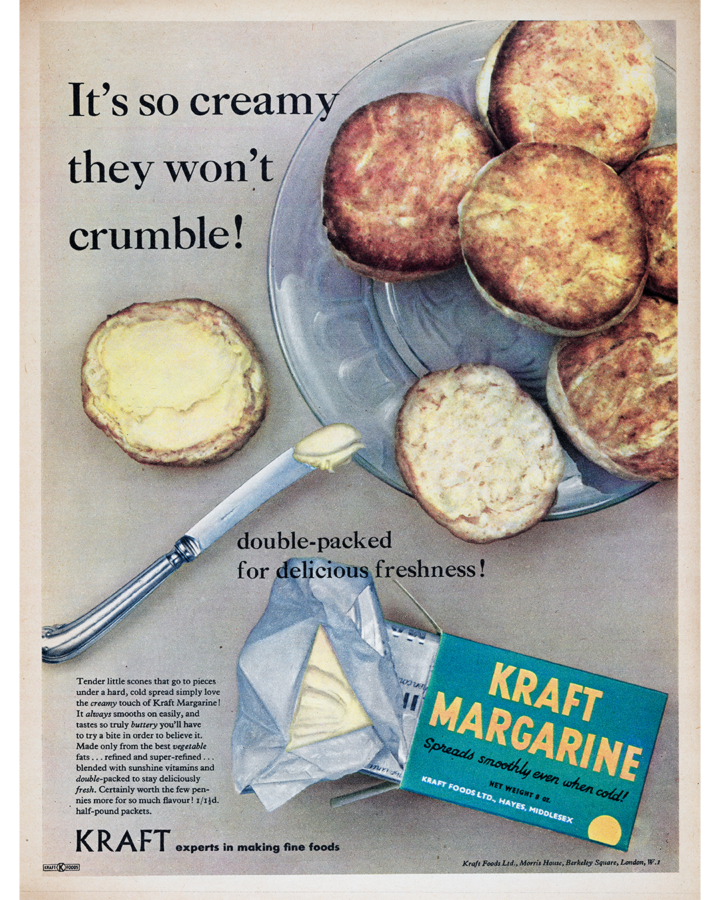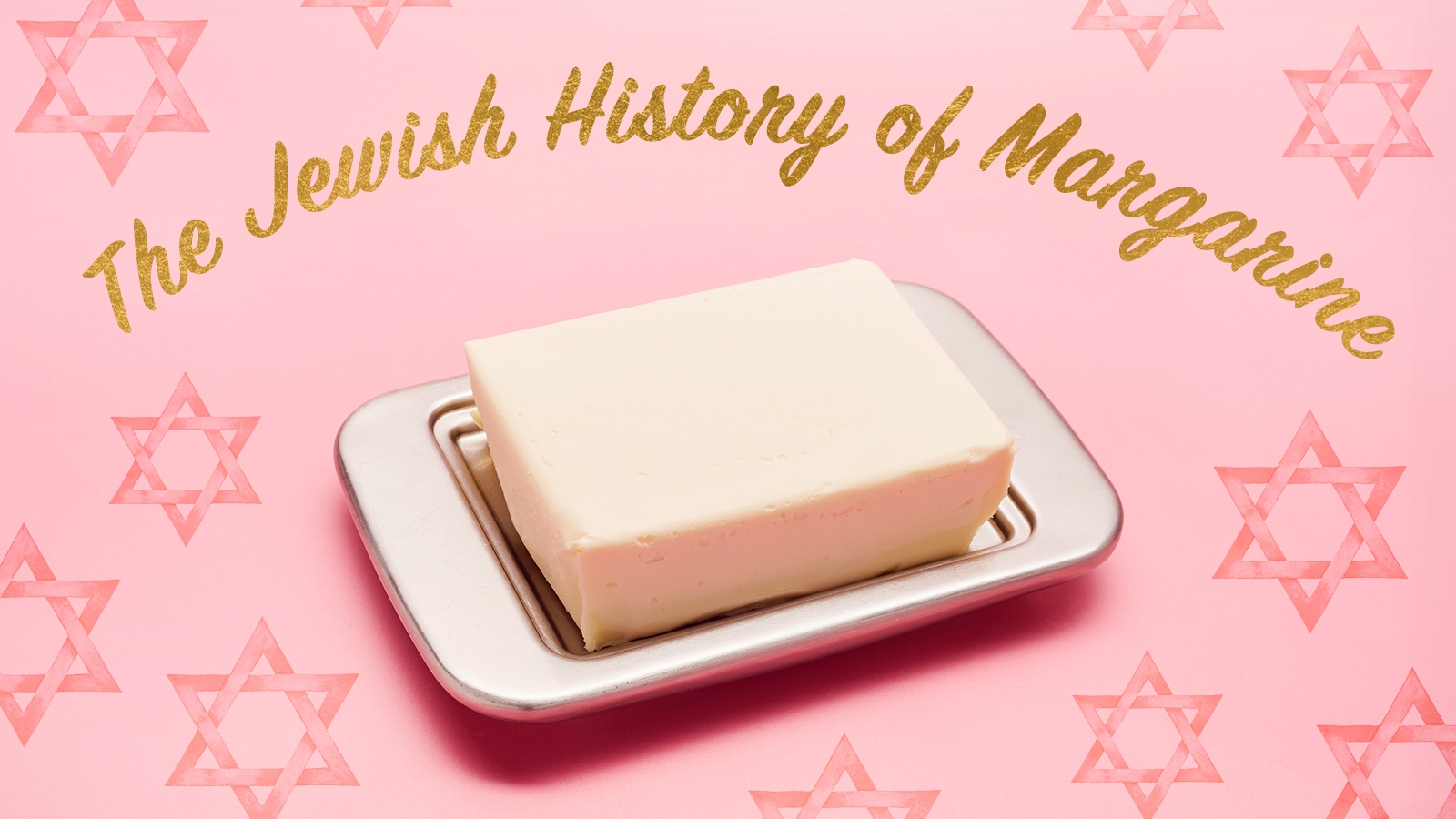With butter, everything is better,” once averred Julia Child. But with all due respect to the French chef, for many Jews, margarine reigns supreme. While this love affair with the spread stems in part from Jewish dietary laws forbidding the mixing of meat and dairy, this enthusiasm for margarine transcends religious dicta, for many who are, in theory, comfortable with buttering their brisket, so to speak, still favor margarine over butter.
Why? For some, it’s a sense of nostalgia. A tub of margarine may have been a ubiquitous fixture in the refrigerator growing up.
For others, it’s for (perceived) salutatory reasons. As the post-World War II generations of Americans became increasingly reliant on processed food, diet-conscious (then not so much a contradiction in terms) margarine was advertised as the “healthier” alternative, and replaced butter in many households. Paving the way for this supplantation was Jewish food scientist and entrepreneur Charles Louis Fleischmann.
But before we delve deeper into Fleishmann’s creamy corn oil contributions, a primer on margarine: Invented in 1869 by French chemist Hippolyte Mège-Mouriés, margarine (originally called oleomargarine, a portmanteau of the Latin word for “olive oil” and the Greek word for “pearl”) is an emulsion of water in fat produced by refining vegetable oil. It was first patented in the United States in 1871, with the Oleo Margarine Manufacturing company opening in New York in 1873. Demand for this butter substitute was immediately high, not only because margarine was cheaper but also because its quality was more uniform compared to butter, which due to being usually made in small farms, varied in composition. Despite the fact that some found margarine’s pale white color unappetizing (it would only be tinted yellow later to appeal to consumer preferences) 126 million pounds of margarine had been sold in the United States by 1902.
The Nosher celebrates the traditions and recipes that have brought Jews together for centuries. Donate today to keep The Nosher's stories and recipes accessible to all.
The dairy lobby responded by challenging the supposed health benefits of margarine and the conditions under which it was produced, first via public relations campaigns and then through legislation. In 1884, New York outlawed margarine but the ban was quickly overturned in the state Court of Appeals, which deemed the initial ruling unconstitutional for unfairly stifling competition. Other states passed strict regulations regarding margarine, most notably Wisconsin, where it was illegal for restaurants and food service businesses to substitute margarine for butter. The Oleomargarine Act, signed by President Grover Cleveland in 1886, outlined margarine could only be sold if it was packaged and labeled in such a way as to readily distinguish it from butter for the consumer. Although several states subsequently instituted additional heavy taxes on margarine (the majority of which were repealed by the 1950s), it remained competitive, eventually edging out butter during the the Great Depression when its comparatively lower price tag was a boon to struggling Americans.

And a major player through this saturated fat saga was Jewish immigrant Charles Louis Fleischmann.
Fleischmann (whose name ironically translates to “meat man” in German) first set his sights on besting bread, not butter. In the 1860s, Fleischmann, whose father was a distiller, journeyed from Austria to the United States with, according to legend, a vial of baker’s yeast in his vest pocket in order to improve what he considered the lackluster quality of American bread. After successfully debuting their product at the 1876 Centennial Exposition, Fleischmann and his brother Maximillian founded their namesake yeast company. Over the next few decades, Fleischmann’s Yeast rose to become a household name, its popularity bolstered by intense advertising in the 1930s touting their yeast as the cure for “intestinal fatigue”, constipation and acne. In 1943, Fleischmann’s introduced the first active dry yeast, securing their place in the market as a necessary staple for the home baker.
Following the merger of the Fleischmann’s Yeast with Standard Brands in 1929, a Royal Gelatin plant was constructed to the corporate headquarters in Peekskill, New York. Utilizing that technology, Fleischmann tried his hand at creating his own version of margarine by aerating vegetable oil and chopping it into blocks. Promising early sales of the product spurred increased production as well as diversification; in the 1960s, Fleischmann’s introduced its margarine as “the perfect bread topper,” which was hailed by nutritionists at the time as a“polyunsaturated weapon against excessive serum cholesterol.” Other innovations and variants were later debuted including an “extra light” version (1990) and “Fat-Free Buttery Squeeze” container (1994).
Mega grocery store broker James Qualls immortalized his endorsement of Fleishmann’s margarine in this pithy jingle:
Last name’s Qualls, first name’s James.
Callin’ on stores’ like playin’ games.
Fleischmann’s margarine’s fun to sell,
If they don’t buy it, they can go to hell.
But in 2023, Butter Is Back, baby. The meteoric rise of celebrity chefs all too eager to wax poetic on the merits of animal fats in the first two decades of the 21st century combined with the TikTok trend of fancy “butter boards” means that butter is having a moment.
For many Jews, however, there is still room for margarine. In addition to the nostalgia factor, some find that this sunny yellow pseudo-fat imparts its own distinct, irreplaceable flavor. Christopher Brugler, aka “The Challah King” of Beverly Hills, insists on using margarine, not butter, in his challah recipe. Most kugel recipes (including one dish served in The White House for the High Holidays) also explicitly invoke margarine as an acceptable fat option. Tradition and nostalgia, it seems, trump health and litigation.



